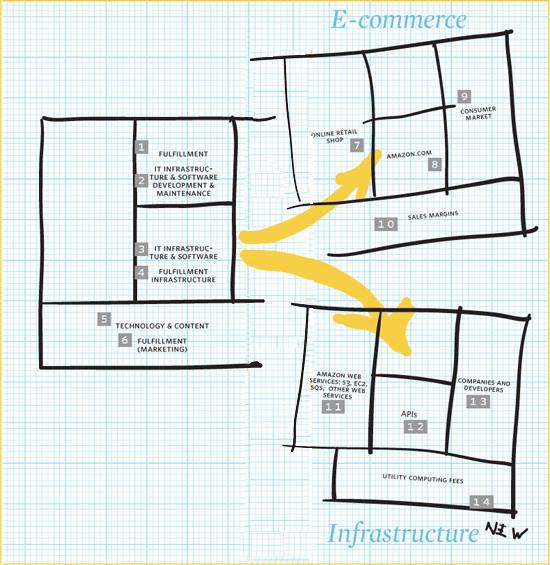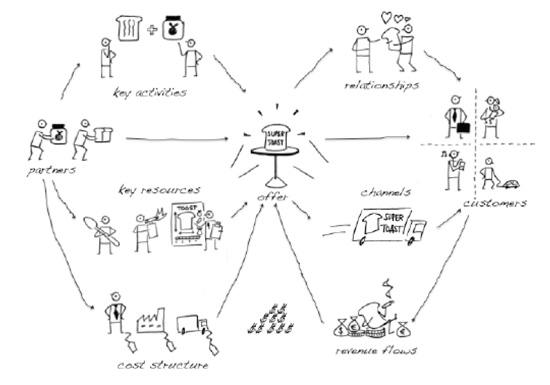
Technique_No. 5
Storytelling

Spring, 2007
It is already far past midnight as Anab Jain watches the latest video footage she shot during the day . . .
. . . She’s working on a series of small films for Colebrook Bosson Saunders, a designer and manufacturer of award-winning office furniture accessories. Anab is a storyteller and designer, and the films she is working on are part of a project to help Colebrook Bosson Saunders make sense of how the future of work and the workplace could look. To make this future tangible, she invented three protagonists and projected them into 2012. She gave them new jobs based on research into new and emerging technologies and the impact of demographics and environmental risks on our future lives. The films then show this near future. But rather than describing 2012, Anab takes the role of the storyteller, visiting this future environment and interviewing the three protagonists. They each explain their work and show objects they use. The films are real enough to cause viewers to suspend their disbelief and become intrigued by the different environment. That is exactly what companies that hire Anab Jain, like Microsoft and Nokia, are looking for: stories to make potential futures tangible.
Storytelling’s Value
As parents, we read stories to our kids, sometimes the same ones we heard as children ourselves. As colleagues, we share the latest organizational gossip. And as friends, we tell one another stories of our personal lives. Somehow, it is only in our roles as businesspeople that we avoid using stories. This is unfortunate. When was the last time you heard a story used to introduce and discuss a business issue? Storytelling is an undervalued and underused art in the world of business. Let’s examine how storytelling can serve as a powerful tool to make new business models more tangible.
By their very nature, new or innovative business models can be difficult to describe and understand. They challenge the status quo by arranging things in unfamiliar ways. They force listeners to open their minds to new possibilities. Resistance is one likely reaction to an unfamiliar model. Therefore, describing new business models in a way that overcomes resistance is crucial.
Just as the Business Model Canvas helps you sketch and analyze a new model, storytelling will help you effectively communicate what it is all about. Good stories engage listeners, so the story is the ideal tool to prepare for an in-depth discussion of a business model and its underlying logic. Storytelling takes advantage of the explanatory power of the Business Model Canvas by suspending disbelief in the unfamiliar.
Why Storytelling?
Introducing the New
New business model ideas can pop up anywhere in an organization. Some ideas may be good, some may be mediocre, and some may be, well, completely useless. But even outstanding business model ideas can have a tough time getting past layers of management and finding their way into an organization’s strategy. So effectively pitching your business model ideas to management is crucial. This is where stories can help. Ultimately, managers are interested in numbers and facts, but having the right story can win their attention. A good story is a compelling way to quickly outline a broad idea before getting caught up in the details.
Make the New Tangible

Explaining a new, untested business model is like explaining a painting with words alone. But telling a story of how the model creates value is like applying bright colors to canvas. It makes things tangible.
Pitching to Investors
If you are an entrepreneur, chances are you will pitch your idea or business model to investors or other potential shareholders (and you already know that investors stop listening the instant you tell them how you will become the next Google). What investors and other shareholders want to know is: How will you create value for customers? How will you make money doing so? That’s the perfect setting for a story. It’s the ideal way to introduce your venture and business model before getting into the full business plan.
Clarification

Telling a story that illustrates how your business model solves a customer problem is a clear way to introduce listeners to the idea. Stories give you the “buy-in” needed to subsequently explain your model in detail.
Engaging Employees
When an organization transitions from an existing business model to a new business model, it must convince collaborators to follow. People need a crystal clear understanding of the new model and what it means for them. In short, the organization needs to powerfully engage its employees. That is where traditional text-based PowerPoint presentations usually fail. Introducing a new business model through an engaging story-based presentation (delivered with PowerPoint, drawings, or other techniques) is far more likely to connect with listeners. Capturing people’s attention and curiosity paves the way for in-depth presentations and discussions of the unfamiliar.
Engaging People

People are moved more by stories than by logic. Ease listeners into the new or unknown by building the logic of your model into a compelling narrative.
Making Business Models Tangible?
The goal of telling a story is to introduce a new business model in an engaging, tangible way. Keep the story simple and use only one protagonist. Depending on the audience, you can use a different protagonist with a different perspective. Here are two possible starting points.

Employee Observer
Explain the business model in the form of a story told from an employee’s perspective. Use the employee as the protagonist who demonstrates why the new model makes sense. This may be because the employee frequently observes customer problems that the new business model solves. Or it may be that the new model makes better or different use of resources, activities, or partnerships compared to the old model (e.g. cost reduction, productivity improvement, new revenue sources, etc.). In such a story, the employee embodies the inner workings of an organization and its business model and shows the reasons for transitioning to a new model.


Customer Jobs
The customer perspective provides a powerful starting point for a story. Cast a customer as the protagonist and tell the tale from her point of view. Show the challenges she faces and which jobs she must get done. Then outline how your organization creates value for her. The story can describe what she receives, how it fits into her life, and what she is willing to pay for. Add some drama and emotion to the story, and describe how your organization is making her life easier. Ideally, weave in how your organization gets these jobs done for the customer, with which resources and through which activities. The biggest challenge with stories told from a customer perspective is keeping them authentic and avoiding a facile or patronizing tone.
Making the Future Tangible
Stories offer a wonderful technique for blurring the lines separating reality and fiction. Thus stories provide a powerful tool for imparting tangibility to different versions of the future. This can help you challenge the status quo or justify adopting a new business model.
CURRENT BUSINESS MODEL

WHAT FUTURE BUSINESS MODEL?
Provoke Ideas
Sometimes a story’s sole purpose is to challenge the organizational status quo. Such a story must bring vividly to life a future competitive environment in which the current business model is severely challenged or even obsolete. Telling a story like this blurs the lines between reality and fiction and catapults listeners into the future. This suspends disbelief, instills a sense of urgency, and opens the audience’s eyes to the need to generate new business models. Such a story can be told from either an organization or a customer perspective.
PLANNED FUTURE BUSINESS MODEL
Justify Change
Sometimes an organization has strong ideas about how its competitive landscape will evolve. In this context, a story’s purpose is to show how a new business model is ideally suited to help an organization compete in the new landscape. Stories temporarily suspend disbelief and help people imagine how the current business model should evolve to remain effective in the future. The story’s protagonist could be a customer, an employee, or a top manager.
Developing the Story
The goal of telling a story is to introduce a new business model in an engaging, tangible way. Keep the story simple and use only one protagonist. Depending on the audience, you can use a different protagonist with a different perspective. Here are two possible starting points.

Company Perspective
Ajit, 32, Senior IT Manager, Amazon.com

Ajit has worked for Amazon.com as an IT manager for the past nine years. He and his colleagues have pulled countless all-nighters over the years to deliver the world-class IT infrastructure that serves and maintains the company’s e-commerce business.
Ajit is proud of his work. Along with its fulfillment excellence (1, 6), Amazon.com’s powerful IT infrastructure and software development capabilities (2, 3) form the heart of its success at selling everything from books to furniture online (7). Amazon.com (8) delivered over half a billion page impressions to online shoppers (9) in 2008, and spent over a billion dollars for technology and content (5), notably to run its e-commerce operations.
But now Ajit is even more excited, because Amazon.com is traveling far beyond its traditional retail offers. It’s in the process of becoming one of the most important infrastructure providers in e-commerce.
With a service called Amazon Simple Storage Systems (Amazon S3) (11) the company is now using its own IT infrastructure to provide online storage to other companies at rock-bottom prices. This means that an online video hosting service can store all customer videos on Amazon’s infrastructure rather than buying and maintaining its own servers. Similarly, Amazon Elastic Computing Cloud (Amazon EC2)(11) offers Amazon.com’s own computing capability to outside clients.
Ajit knows that outsiders might view such services as distracting Amazon.com from its core retail operations. From the inside, though, the diversification makes perfect sense.
Ajit remembers that four years ago, his group spent much time coordinating the efforts of the network engineering groups, which managed IT infrastructure, and the applications programming groups, which managed Amazon.com’s many Web sites. So they decided to build so-called application programming interfaces (APIs)(12) between these two layers, which would allow the latter to easily build on the former. Ajit also remembers exactly when they started to realize that this would be useful to external as well as internal customers. So under Jeff Bezos’s leadership, Amazon.com decided to create a new business with the potential to generate a significant revenue source for the company. Amazon.com opened up its infrastructure APIs to provide what it calls Amazon Web Services to outside parties on a fee-for-service basis (14). Since Amazon.com had to design, create, implement, and maintain this infrastructure anyway, offering it to third parties was hardly a distraction.
Customer Perspective
Randy, 41, Web Entrepreneur

Randy is a passionate Web entrepreneur. After 18 years in the software industry he is now running his second startup, providing enterprise software through the Web. He spent 10 years of his career in large software companies and eight years in start-ups.
Throughout his career, one constant struggle has been getting infrastructure investments right. To him, running servers to provide services was basically a commodity business, but a tricky one due to the enormous costs involved. Tight management was crucial; when you’re running a start-up you can’t invest millions in a server farm.
But when serving the enterprise market, you’d better have a robust IT infrastructure in place. That’s why Randy was intrigued when a friend at Amazon.com told him about the new IT infrastructure services his company was launching. That was the answer to one of Randy’s most important in-house jobs: running his services on a world-class IT infrastructure, being able to scale quickly, and all the while paying only for what his company was actually using. That was exactly what Amazon’s Web Services (11) promised. With Amazon Simple Storage Systems (Amazon S3), Randy could plug into Amazon’s infrastructure through a so-called application programming interface (API)(12) and store all the data and applications for his own services on Amazon.com’s servers. The same went for Amazon’s Elastic Computing Cloud (Amazon EC2). Randy didn’t have to build and maintain his own infrastructure to crunch the numbers for his enterprise application service. He could simply plug into Amazon and use its computing power in return for hourly usage fees (14).
He immediately understood why the value was coming from the giant e-tailer rather than from IBM or Accenture. Amazon.com was providing and maintaining IT infrastructure (2, 3, 5) to serve its online retail business (7) every day on a global scale. This was its core competency. Taking the step to offer the same infrastructure services to other companies (9) was not much of a stretch. And since Amazon.com was in retail, a business with low margins (11), it had to be extremely cost-efficient (5), which explained the rock-bottom prices of its new Web Services.
Techniques
Telling an engaging story can be done in different ways. Each technique has advantages and disadvantages and is better suited for certain situations and audiences. Choose a suitable technique after you understand who your audience will be and the context in which you will present.
Talk & Image

DESCRIPTION
Tell the story of a protagonist and his environment using one or several images
WHEN?
Group or conference presentation
TIME & COST
Low
Video Clip

DESCRIPTION
Tell the story of a protagonist and his environment using video to blur lines between reality and fiction
WHEN?
Broadcast to large audiences or in-house use for decisions with important financial implications
TIME & COST
Medium to high
Role Play

DESCRIPTION
Have people play the roles of a story’s protagonists to make the scenario real and tangible
WHEN?
Workshops where participants present newly developed business model ideas to each other
TIME & COST
Low
Text & Image

DESCRIPTION
Tell the story of a protagonist and his environment using text and one or several images
WHEN?
Reports or broadcasts to large audiences
TIME & COST
Low
Comic Strip

DESCRIPTION
Use a series of cartoon images to tell the story of a protagonist in a tangible way
WHEN?
Reports or broadcasts to large audiences
TIME & COST
Low to medium
SuperToast, Inc. Business Model
Start practicing your business model storytelling skills with this simple, slightly silly exercise: The business model of SuperToast, Inc. outlined in the Canvas below. You can start anywhere you like: with Customers, the Value Proposition, Key Resources, or elsewhere. Invent your own story. The only constraints are the nine images that outline SuperToast Inc.’s business model. Try telling the story several times, starting from different Building Blocks. Each starting point will give the story a slightly different twist and emphasize different aspects of the model.
By the way, this is a wonderful approach to introducing the Business Model Canvas to the “uninitiated” in a simple and engaging way—with a story.

XPLANATION “by XPLANE” ©XPLANE 2008